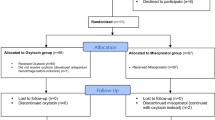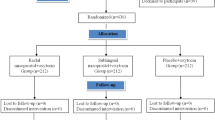Abstract
Background
Post-partum hemorrhage (PPH) is the most common direct cause of maternal mortality and timely intervention can save many lives.
Objective
To compare the effectiveness of sublingual misoprostol to intravenous oxytocin in preventing post-partum hemorrhage in low risk vaginal birth.
Methods
One hundred patients with no risk factor for PPH were randomly allocated to receive 600 μg misoprostol administered sublingually or 10 IU of intravenous oxytocin immediately after the delivery of baby. Main outcome measures were post-partum blood loss, drop in hemoglobin in 24 h, duration of third stage of labor, and drug-related adverse effects.
Results
Mean age, parity and gestational age were similar in both groups. Mean blood loss was significantly lower in oxytocin group (114.28 ± 26.75 versus 149.50 ± 30.78 ml; p = 0.00). Drop in hemoglobin was 0.31 ± 0.16 versus 0.49 ± 0.21 g% (p = 0.01) in oxytocin and misoprostol group, respectively. Duration of third stage labor was shorter in oxytocin group (median 5 min, IQR: 4.5–5.5 versus 5.5 min, IQR: 5–6 min, p < 0.01). Although fever and shivering were common adverse effects with misoprostol but were not clinically significant.
Conclusion
Intravenous oxytocin is more efficacious than sublingual misoprostol in preventing PPH in institutional deliveries.
Similar content being viewed by others
References
Potts M, Prata N, Sahin–Hodoglugil NN (2010) Maternal mortality: one death every 7 min. Lancet 375:1762–1763
Mathai M, Gulmezoglu AM, Hill S (2007) Saving womens lives: evidence-based recommendations for the prevention of postpartum haemorrhage. Bull World Health Organ 85:322–323
Rogers J, Wood J, McCandlish R, Ayers S, Truesdale A, Elbourne D (1998) Active versus expectant management of third stage of labour: the Hinchingbrooke randomised controlled trial. Lancet 351:693–699
Aflaifel N, Weeks AD (2012) Active management of the third stage of labour. BMJ 345:e4546
McDonald SJ, Middleton P (2008) Effect of timing of umbilical cord clamping of term infants on maternal and neonatal outcomes. Cochrane Database Syst Rev CD004074
Gulmezoglu AM, Lumbiganon P, Landoulsi S, Widmer M, Abdel–Aleem H, Festin M et al (2012) Active management of the third stage of labour with and without controlled cord traction: a randomised, controlled, non-inferiority trial. Lancet 379:1721–1727
Winikoff B, Dabash R, Durocher J, Darwish E, Nguyen TN, Leon W et al (2010) Treatment of post-partum haemorrhage with sublingual misoprostol versus oxytocin in women not exposed to oxytocin during labour: a double-blind, randomised, non-inferiority trial. Lancet 375:210–216
Roach MK, Abramovici A, Tita AT (2012) Dose and duration of oxytocin to prevent postpartum hemorrhage: a review. Am J Perinatol
Carroli G, Cuesta C, Abalos E, Gulmezoglu AM (2008) Epidemiology of postpartum haemorrhage: a systematic review. Best Pract Res Clin Obstet Gynaecol 22:999–1012
Tang OS, Gemzell–Danielsson K, Ho PC (2007) Misoprostol: pharmacokinetic profiles, effects on the uterus and side-effects. Int J Gynaecol Obstet 99(Suppl 2):S160–S167
(2011) The selection and use of essential medicines. World Health Organ Tech Rep Ser i–xiv, pp 1–249
Hofmeyr GJ, Gulmezoglu AM, Novikova N, Linder V, Ferreira S, Piaggio G (2009) Misoprostol to prevent and treat postpartum haemorrhage: a systematic review and meta-analysis of maternal deaths and dose-related effects. Bull World Health Organ 87:666–677
Tuncalp O, Hofmeyr GJ, Gulmezoglu AM (2012) Prostaglandins for preventing postpartum haemorrhage. Cochrane Database Syst Rev 8:CD000494
Sheldon WR, Blum J, Durocher J, Winikoff B (2012) Misoprostol for the prevention and treatment of postpartum hemorrhage. Expert Opin Investig Drugs 21:235–250
Smith JM, Gubin R, Holston MM, Fullerton J, Prata N (2013) Misoprostol for postpartum hemorrhage prevention at home birth: an integrative review of global implementation experience to date. BMC Pregnancy Childbirth 13:44
Elati A, Elmahaishi MS, Elmahaishi MO, Elsraiti OA, Weeks AD (2011) The effect of misoprostol on postpartum contractions: a randomised comparison of three sublingual doses. BJOG 118:466–473
Chaudhuri P, Biswas J, Mandal A (2012) Sublingual misoprostol versus intramuscular oxytocin for prevention of postpartum hemorrhage in low-risk women. Int J Gynaecol Obstet 116:138–142
Singh G, Radhakrishnan G, Guleria K (2009) Comparison of sublingual misoprostol, intravenous oxytocin, and intravenous methylergometrine in active management of the third stage of labor. Int J Gynaecol Obstet 107:130–134
Bellad MB, Tara D, Ganachari MS, Mallapur MD, Goudar SS, Kodkany BS et al (2012) Prevention of postpartum haemorrhage with sublingual misoprostol or oxytocin: a double-blind randomised controlled trial. BJOG 119:975–982; discussion 982–986
Montagu D, Yamey G, Visconti A, Harding A, Yoong J (2011) Where do poor women in developing countries give birth? A multi-country analysis of demographic and health survey data. PLoS ONE 6:e17155
Conflict of interest
We declare that we have no conflict of interest. We have full control on primary data and we allow the journal to review our data if requested.
Author information
Authors and Affiliations
Corresponding author
Additional information
Dr. R. Tewatia was previously working in Department of Obstetrics and Gynecology, Batra Hospital and Medical Research Center, New Delhi.
Rights and permissions
About this article
Cite this article
Tewatia, R., Rani, S., Srivastav, U. et al. Sublingual misoprostol versus intravenous oxytocin in prevention of post-partum hemorrhage. Arch Gynecol Obstet 289, 739–742 (2014). https://doi.org/10.1007/s00404-013-3026-2
Received:
Accepted:
Published:
Issue Date:
DOI: https://doi.org/10.1007/s00404-013-3026-2




